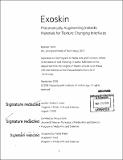| dc.contributor.advisor | Hiroshi Ishii. | en_US |
| dc.contributor.author | Tome, Basheer | en_US |
| dc.contributor.other | Massachusetts Institute of Technology. Department of Architecture. Program in Media Arts and Sciences. | en_US |
| dc.date.accessioned | 2016-03-25T13:38:16Z | |
| dc.date.available | 2016-03-25T13:38:16Z | |
| dc.date.copyright | 2015 | en_US |
| dc.date.issued | 2015 | en_US |
| dc.identifier.uri | http://hdl.handle.net/1721.1/101825 | |
| dc.description | Thesis: S.M., Massachusetts Institute of Technology, School of Architecture and Planning, Program in Media Arts and Sciences, 2015. | en_US |
| dc.description | Cataloged from PDF version of thesis. | en_US |
| dc.description | Includes bibliographical references (pages 105-108). | en_US |
| dc.description.abstract | Programmable materials have the power to bring to life inert materials in the world around us. Exoskin, provides a way to embed a multitude of static, rigid materials into actuatable, elastic membranes, allowing the new semi-rigid composites to sense, react, and compute. In this thesis, we give an overview of our motivations, design space, and molding architecture that together answer the when, where, and how of Exoskin's use. We then use Exowheel, an automotive steering wheel, as a case study illustrating the concrete benefits and uses of texture change as a multi-modal, bi-directional interface. By incorporating Exoskin, Exowheel is able to transform its surface dynamically to create a customized grip for each individual user, on-the-fly, as well as to adapt the grip during the drive, as the car moves from congested city driving to rougher rural roads. Finally, we introduce the idea of membrane-backed rigid materials as a broader, more versatile platform for introducing texture change and sensing into a variety of other products as well. By deeply embedding soft materials with more-static materials, we can break down the divide between rigid and soft, and animate and inanimate, providing inspiration for Human-Computer Interaction researchers to design more interfaces using physical materials around them, rather than just relying on intangible pixels and their limitations. | en_US |
| dc.description.statementofresponsibility | by Basheer Tome. | en_US |
| dc.format.extent | 108 pages | en_US |
| dc.language.iso | eng | en_US |
| dc.publisher | Massachusetts Institute of Technology | en_US |
| dc.rights | M.I.T. theses are protected by copyright. They may be viewed from this source for any purpose, but reproduction or distribution in any format is prohibited without written permission. See provided URL for inquiries about permission. | en_US |
| dc.rights.uri | http://dspace.mit.edu/handle/1721.1/7582 | en_US |
| dc.subject | Architecture. Program in Media Arts and Sciences. | en_US |
| dc.title | Exoskin : pneumatically augmenting inelastic materials for texture changing interfaces | en_US |
| dc.title.alternative | Pneumatically augmenting inelastic materials for texture changing interfaces | en_US |
| dc.type | Thesis | en_US |
| dc.description.degree | S.M. | en_US |
| dc.contributor.department | Program in Media Arts and Sciences (Massachusetts Institute of Technology) | |
| dc.identifier.oclc | 941793425 | en_US |
